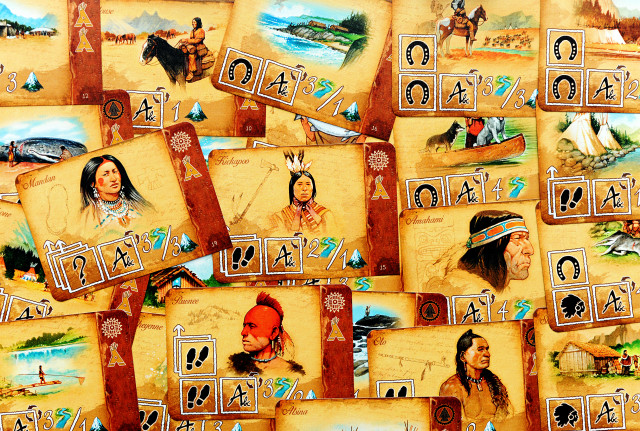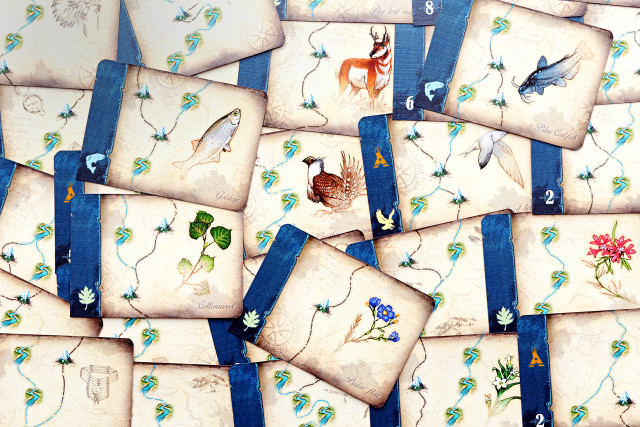Cédrick Chaboussit and Vincent Dutrait have been on a two-year journey together, not unlike Meriwether Lewis and William Clark. It began with the critical hit, Lewis & Clark: The Expedition, published in 2013 to wild acclaim. They’ve followed The Expedition up with a sequel of sorts, Discoveries: The Journals of Lewis & Clark.
Discoveries may look like an expansion at first glance. The same art from Dutrait gives it an extraordinarily similar feel to The Expedition. But Discoveries stands on its own. It’s a dice-based action selection game that explores not only the journey that Lewis & Clark embarked upon, but also the diligent work they did to record the flora and fauna native to the American countryside. In Discoveries, players will not only be traveling from Camp Dubois in search of the Pacific Ocean; they will be finding new species of plants, mammals, birds and fish, and making contact with peaceful and wary American Indian tribes.
The goal of the game is to record as much knowledge as possible as you journey across the country. Each player will take on the role of one of the expedition leaders: Lewis, Clark, Patrick Gass or John Ordway. Records can be kept of the various American Indian tribes you encounter, the different plants and animals you come across, and one can even map the land itself. The player that has acquired the most knowledge of the American landscape will be the winner.
Each player has their own tableau to work on, and the main board has both a meeting area featuring the available tribe cards and a reconnaissance area where discoveries cards can be acquired. At any given time players will be working to complete one discoveries card by fulfilling the necessary exploration actions to traverse the different land types (mountain or river) depicted on the card, from the bottom to the top.
Each turn, players will choose to either spend dice from their action zone to start or complete tasks, or to rest and reclaim dice from around the board. When spending dice on actions, only one type of die face can be used per turn. When dice are used they are discarded onto the main board. The right bank holds discarded ‘journal’ and ‘negotiate’ dice and the left bank holds ‘walk’ and ‘ride’ dice.
 Certain actions, such as taking tribe cards or changing die faces, only require one turn to complete. You spend the necessary dice and execute the action. In the case of taking a tribe card, you add the card to your tableau. Tribe cards will provide another action space or special ability to help you throughout the course of the game. Tribe cards also contain a number of teepees. The more teepees you have on completed tribe cards at the end of the game, the more points they’re worth.
Certain actions, such as taking tribe cards or changing die faces, only require one turn to complete. You spend the necessary dice and execute the action. In the case of taking a tribe card, you add the card to your tableau. Tribe cards will provide another action space or special ability to help you throughout the course of the game. Tribe cards also contain a number of teepees. The more teepees you have on completed tribe cards at the end of the game, the more points they’re worth.
Other actions require different combinations of dice to be completed, and will therefore require more turns to complete. For example, exploration actions might call for a ‘walk’ or ‘horseshoe’ result, but before the task is completed, players will have to spend another turn recording their experiences. It’s great to have completed the exploration, but without recording the information they’ve achieved there really was no point. After all, the diligent notes that Lewis & Clark made were important to the understanding of America at that time.
 Once a discoveries card has been fully traversed, it is added to the player’s journal for end game points. Some of the discoveries cards also depict a species of plant or animal in one of four different types. Collecting sets of different species will also earn points at the end of the game. From the available cards in the reconnaissance area, players take a new discoveries card to work on.
Once a discoveries card has been fully traversed, it is added to the player’s journal for end game points. Some of the discoveries cards also depict a species of plant or animal in one of four different types. Collecting sets of different species will also earn points at the end of the game. From the available cards in the reconnaissance area, players take a new discoveries card to work on.
The other option for players on a turn is to rest. Resting allows players to gain more dice to use for future actions. They can take all the dice from either the left or right bank on the main board or all of their own coloured dice from anywhere, including those in use by other players. Once they’ve collected their dice, they will roll them and add them to their stock. Throughout the course of the game player’s dice might get swapped back and forth. The dice represent members of the party that would be sent out on different missions over the course of the entire expedition.
Unlike a lot of dice action games published these days, there are a lot of tough decisions to make and strategizing required to do well in Discoveries. It’s an accessible game, but one with almost as many paths to victory as there are to traverse the United States.
Discoveries was a hotly anticipated game at GenCon 2015, and I think fans of the series will not be disappointed. It keeps the flavour of exploring America in the early 1800s, while delivering a completely different gaming experience than The Expedition. Even if you’ve never tried the original, you can have a great time with Discoveries. I appreciate the attention to detail put into the historical accuracy of the game. Each of the different playable characters has their own bio section in the rulebook and there is a detailed timeline of the major events that occurred between May 1804 and September 1806.
Comments
No comments yet! Be the first!